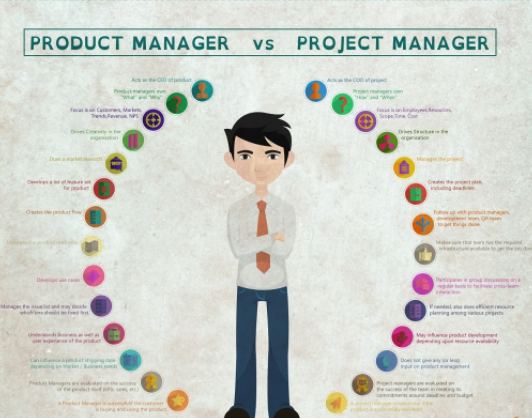Despite the similar names, there are some big differences between project manager and product manager. They are often used interchangeably but are different disciplines requiring quite different skills. In a nutshell,
* The product manager is to do the right thing and make sure the product be line with the market demand, giving the company profits the highest priority.
* The project manager is to do the thing in a right way and make sure things conducted perfect, taking time, cost as well as resource constraints into consideration in order to complete the ultimate goal.
Before diving into more details, let's take a prior look at what is project management and product management in below.
1. What Is Project and Project Management?
Simply speaking, the project is usually temporary work for outputting unique products, services and results. Project management is the application of knowledge, skills, tools and technology within the project activities in order to meet the current needs. This process includes project initiation, planning, execution, monitoring and project closure. As a project manager, the target is to manage the involved people, events and things to establish the project activities through careful planning.
2. What Is Product and Product Management?
Products are anything that can be provided to the market, used and consumed by people, and of course can satisfy people's needs, including tangible goods, intangible services, organizations, ideas or a combination of these. Project management is the business activity of enterprise's living organization in the product life cycle, such as product plan, development, marketing, sales and support to manage the business activities. The product manager are mainly responsible for market research, user research and defining the products in accordance with the users' needs. They also consider the product's business model, operation and promotion approaches.
3. Project Manager Vs. Product Manager - Differences
Firstly, the project manager requires a technical background, and in the IT company, they have to be very experienced with the responsibility to convert the objectives into quantified and achieved project plan, giving emphasis on management and implementation.
However, the product manager doesn't require technical knowledge but needs to be knowledgeable in the field. Nowadays in the recruitment requirements for product manager in IT industry, the employees should have relevant work experience, informative in the Internet products, proficient in product design process (function analysis, user role analysis, prototyping, interface development, user testing, etc), with the excellent ability to express, write documentations and skills in using prototype design tools, including Axure, Mockplus, Justinmind or Balsamiq. The actual development capability is not necessarily required.
Moreover, from the responsibility cycle, the project manager should be responsible for the completion of a project, and then seamlessly switch to another project. However, the product manager should grow with the product, along with countless items.

4. Project Manager Vs. Product Manager - Relations
The product managers and project managers, in fact, work in a very close relationship, and it's hard to set them apart from each other. For instance, e product manager needs to collaborate with the project manager under the relevant progress to ensure the project can meet the final quality and quantity on time.
In practice, the division of product manager and project manager is clear in the large-sized company; but the two positions are usually undertaken by the same people in the small to medium-sized companies in order to save manpower and communication cost. Of course, neither the project manager or the product manager, they both should keep learning and make continuous progress in order to adapt to progress in job requirements and market. As all is known, only change never changes always the time. If you have thoughts to share with us on this topic, please comment below, thanks!
Comments
Post a Comment